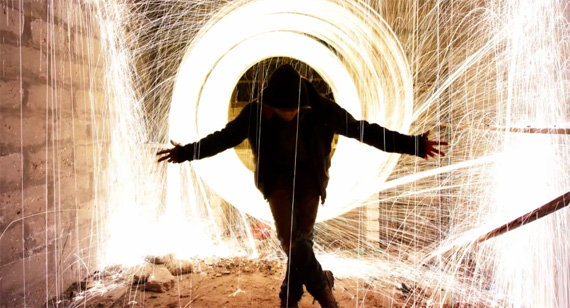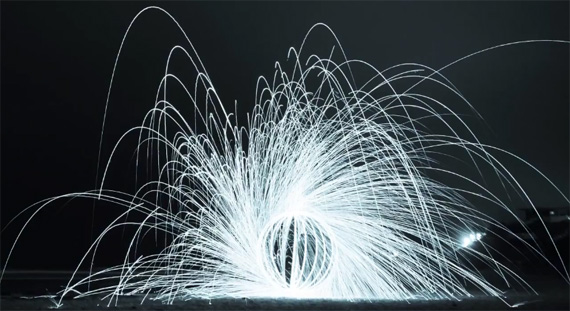Light painting can be done using a variety of techniques. One of the more common methods involves a very dark setting and a handheld LED light that’s used to write or draw into the air while a photograph is being exposed. If done correctly, the resulting graffiti-like photograph can look visually stunning. While light painting itself is a pretty cool concept, when you add a sparking wad of steel wool to the equation, it really captures the viewer’s attention. Here is a great tutorial about this fascinating technique. Check it out:

Montreal based photographer, Ben Von Wong does a great job explaining the technique in the video, but in case you missed part of it, or just need to see it in writing, here are a few pointers to get you started:
- To make the contraption that holds the steel wool and is used to spin it, you will need a few things: A 9-volt battery, a metal whisk, steel wool (size 0-0000), and a length of metal chain long enough to allow you to swing the entire thing around. At the minimum, go with arm’s length—preferably longer. The chain doesn’t need to be heavy duty; just make sure it’s not going to break mid-light painting and launch your sparking steel wool.
- Take a wad of the steel wool and fluff it up by pulling at it. Be careful not to pull chunks off of it. Just stretch enough so it’s puffy. Stuff the stretched steel wool into an opening on the whisk. Once it’s in there, you may need to stretch some of it back out so it fills out the whisk.
- Attach the chain to the handle of the whisk. You should be able to clamp a chain link directly onto the whisk by latching it to the hole in the end that is meant to be used to hang the whisk. If you can’t get the chain secure enough, you can use a small carabiner to assemble the contraption. Put the 9V battery in your pocket, as you’ll need it later to ignite the steel wool.
Now that you’ve got the device put together you’re ready to go out and start light painting. As with any kind of light painting, you’re going to need a dark location. Since we’re working with flammables, you’re also going to need to adhere to a few other safety precautions when location scouting.
It’s best to do steel wool light painting right after rain, so that everything is wet and less likely to ignite. Obviously, don’t attempt this in dry areas or around anything that can catch on fire. When in doubt, the middle of a street is usually a safe choice—just make sure there are no dried leaves, wood, or trash that can get caught in the crossfire and start a fire. And since there is always the possibility to start a fire when doing this, it’s wise to keep a fire extinguisher on hand. Furthermore, the person doing the swinging should always protect themselves by wearing a long-sleeved cotton or fire retardant clothing and a hat. By all means, don’t wear synthetic materials that can melt to your skin!
Now for the fun part: igniting the steel wool and taking photos!
Once you have your location secured and your steel wool holder made, set up your tripod and mount your camera to it. Since it needs to be dark, you may need to use a flashlight to help you focus on where the steel wool will be. As far as camera settings go, Von Wong shoots on ISO 100 at f/5. Your exposure time will, of course, vary greatly depending on your desired effects. Bracket your exposure times and take a few test shot until you get what you’re looking for.
Use the self-timer to eliminate camera shake and also give you some time to get the chain swinging. To ignite the steel wool, touch the end of the 9-volt battery to the steel wool in a few places until it starts sparking. Once it’s lit up, start swinging the chain in circles. The steel wool will only stay lit about half a minute, so work quickly!
Remember, this is a potentially hazardous technique, always practice extreme caution and never attempt to do this alone.
Like This Article?
Don't Miss The Next One!
Join over 100,000 photographers of all experience levels who receive our free photography tips and articles to stay current:









wonderful article for beginners like me. i will try this night ;-)
Great little article, straight to the point and with some nice examples especially the split toned one!
Great advice. I also tried spinning steel wool and wrote a post about it:
http://shutterexperiments.com/2011/04/16/painting-with-light-continued-2/